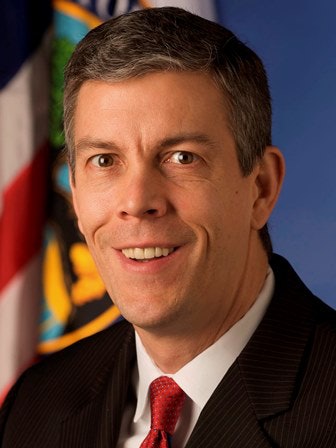 Education Secretary Arne Duncan says, “Sequestration is not an example of smart government.”
Education Secretary Arne Duncan says, “Sequestration is not an example of smart government.”A proposed new $1 billion federal investment in higher education would help states dealing with budget cuts while promoting college completion, as well as access, Education Secretary Arne Duncan said Wednesday.
Duncan told the Senate education appropriations subcommittee that the $1 billion Race to the Top college competition would support innovation while stressing the need to go beyond the goal of simply getting students to enroll at a college or university. “It’s not just about access. It’s about completion,” he told the panel.
While targeting innovation, this new $1 billion in federal seed money also could help reverse the recent trend of state cuts in higher education, the secretary said. The funding would be a new approach for Race to the Top, which so far has funded primarily K-12 education reforms and improvements.
The new program drew a mixed response from lawmakers. Sen. Jon Tester, D-Mont., said smaller, low-population areas have not benefitted greatly from Race to the Top and may lack the resources to deploy grant writers and other experts to develop winning proposals.
Sen. Jerry Moran, R-Kan., also said there is a “consistent concern” that rural areas are not getting their fair share of education grants. Across both Kansas and Montana, eight TRIO programs recently lost their funding. “The Education Department pointed to lack of funding as the major reason,” Tester said. Given the tight fiscal environment, “these schools are now in even worse shape.”
Duncan countered that the department is doing its part to reach out to rural communities and encourage them to seek funds. He noted that among underperforming K-12 schools, 20 percent are rural, yet these schools are getting about 24 percent of funding — slightly more than would be expected. “We know how important rural schools are,” the secretary said.
The administration also is proposing $247 million to launch First in the World, a program the administration describes as “venture capital” to promote innovations. The program’s priorities include initiatives to improve college access and selection for at-risk high school students.
Duncan also touted other increases in the federal budget, including small gains for Pell Grants and a new $750 million initiative to provide seed funds for new state early childhood programs. Overall, the budget also would “reverse the harmful impacts” of sequestration, or the 5 percent across-the-board reductions that went into effect earlier this year.
“Sequestration is not an example of smart government,” Duncan said.
Despite these targeted increases, several senators on both sides of the aisle were critical of the budget plan for not including increases to major formula programs such as Title I education and special education programs. Many of these programs are simply “flat funded,” said Sen. Tom Harkin, D-Iowa.
Elsewhere, the secretary outlined administration plans to convert the current student loan interest rate framework to a market-based approach rather than one requiring regular action by Congress. Without any action on Capitol Hill, interest rates on federal direct student loans will jump from 3.4 percent to 6.8 percent on July 1.
Sen. Jack Reed, D-R.I., urged Duncan to seek “an immediate correction” to stop the July 1 doubling of student loan interest rates. The secretary said doubling rates is “the last thing we want,” but he also said he is interested in a “long-term solution” to the current environment, where lawmakers debate the issue every year.
The administration’s plan would rely on market rates but expand income-based repayment to cushion against the effects of future rate increases. Students would repay their loans based on a portion of their discretionary income.















